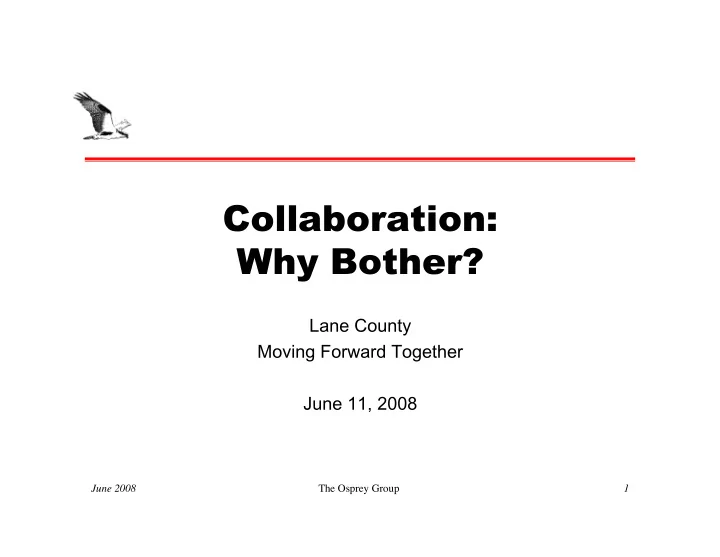

Collaboration: Why Bother? Lane County Moving Forward Together June 11, 2008 June 2008 The Osprey Group 1
Continuum of Conflict Continuum of Conflict Management Approaches Management Approaches Informal Negotiations Collaborative Facilitation/ Arbitration Legislative Judicial Discussion Problem Mediation Admin Decisions Decisions Solving Hearings Proactive Reactive Proactive Reactive Decisions made by the parties Decisions made by third party Greater interdependence Interdependence varies June 2008 The Osprey Group 2
Public Engagement Lots of approaches or techniques Lots of approaches or techniques Need to be clear about the goal for public engagement Need to be clear about the goal for public engagement Right size it Right size it Collaboration can be highly effective, but it should be used in the right circumstances Don’t assume that because you have the collaboration hammer, every problem is a nail June 2008 The Osprey Group 3
Public Involvement Public Involvement Approaches Approaches Public meeting Press release Working meeting Radio call-in show Public hearing Petition Community forum Survey Open house Focus group interviews Blue Ribbon panel Brainstorming sessions Task force Charrette Advisory committees Share background studies or assessments Facilitated dialogue Conflict mediation Use of existing civic groups and others Internet tools Exhibit with feedback device Email Brochures Have an “800” number Meet with opinion leaders June 2008 The Osprey Group 4
Satisfaction with Public Processes Substantive: Were the right issues addressed? Psychological: Procedural: Was Was I heard and the process fair? respected? June 2008 The Osprey Group 5
Collaboration: What is It? People with differing views and interests working together in a systematic and organized way to find workable solutions to shared problems Typical ingredients: Multiple stakeholders with diverse interests Neutral facilitation Decisions by consensus Process agreed to by the parties Multiple viable options identified Government entity is initiator Independent technical resources June 2008 The Osprey Group 6
Not a Panacea Not a good idea when Not a good idea when : Not everyone agrees there is a problem or conflict When one or more of the key parties have better ways to achieve their interests (BATNA) Resolving the issue is not that important to key stakeholders It is difficult to identify stakeholders who are willing to systematically address the issue Decisions need to be made quickly or the decision that will be made is clear Critical thinking is not allowed to generate solutions that are better for everyone Resources are limited and other less expensive approaches can address the problem adequately June 2008 The Osprey Group 7
Ingredients for Success Consider when Consider when : : Issues are high priority to all parties All affected stakeholders are willing and able to participate No single party can resolve the situation on its own There is the view that by working together, a better solution can be reached than by working alone Outcomes or decisions are genuinely in question Implementation is important and commitment to the solution is desired There is reasonable time There are resources available Neutral facilitation is available June 2008 The Osprey Group 8
Collaboration Success Stakeholders Potential for Outcomes High Priority willing to a Better Genuinely in Issues Participate Solution Question June 2008 The Osprey Group 9
Examples Boulder, Colorado Challenge: Recognition of transportation limits and need for more creative solutions Thornton, Colorado Challenge: Following a divisive Walmart siting decision, need for comprehensive land use planning in area that will double size of the City Columbia, Missouri Challenge: Aging Interstate, growing college community, early set positions June 2008 The Osprey Group 10
Collaboration Success I Boulder, Colorado Recognition of Transportation Master Transportation Problem Plan Success Keys Commitment to Beauty Dedicated Team within and Function City Government June 2008 The Osprey Group 11
Collaboration Success II Thornton, Colorado Moratorium on Motivated Council & Development = Desire Community to Seek Solution Success Keys Technical Planning, Advisory Group + Four Economic, Land Use Subcommittees Resources June 2008 The Osprey Group 12
Collaboration Success III Columbia, Missouri Willingness of Advisory Early Assessment Group to Examine Issues Success Keys Independent Non-Defensive Engineering and Participation from Facilitation Services MDOT Representatives June 2008 The Osprey Group 13
Outcomes Outcomes Boulder Boulder Collaborative transportation planning paid huge dividends Alternative infrastructure and programs are implemented and functioning Alternative modes of transportation embraced by the community Thornton Thornton Subarea plan unanimously adopted by City Council Embraced creative campus concept to address identity issue Emphasis on planned commercial development Columbia Columbia MoDOT has consensus plan for expansion of interstate Greatly improved understanding of challenges and tradeoffs June 2008 The Osprey Group 14
West Eugene Collaborative Purpose Statement Purpose Statement ”Develop an integrated land use and transportation solution supported by stakeholders that will facilitate movement of people and commerce from/through/to west Eugene and west of Eugene while enhancing community, business and the environment."
100 Years in Eugene Same spot taken now. (Above train station looking down Willamette. Image courtesy of Special Collections and University Archives, University of Oregon Libraries.
Members
Approach Convening Recommendations Purpose Statement Analysis & Operating Synthesis Agreements Outreach Criteria for Solutions Candidate Solutions/ Options June 2008 The Osprey Group 18
Design Storming
WEC: The Challenge Ahead Meaningful engagement with the community Ability to synthesize and simplify numerous land use, transportation and environmental ideas Ability to develop politically-acceptable, technically-feasible and cost effective recommendations Convey WEC recommendations to agencies with implementation responsibilities
Recommend
More recommend